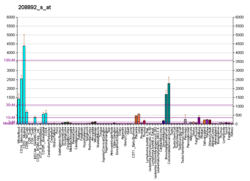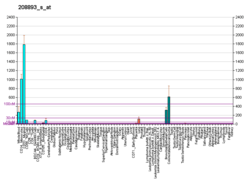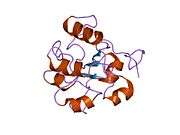DUSP6
Dual specificity phosphatase 6 (DUSP6) is an enzyme that in humans is encoded by the DUSP6 gene.[3][4][5]
Function
The protein encoded by this gene is a member of the dual specificity protein phosphatase subfamily. These phosphatases inactivate their target kinases by dephosphorylating both the phosphoserine/threonine and phosphotyrosine residues. They negatively regulate members of the mitogen-activated protein (MAP) kinase superfamily (MAPK/ERK, SAPK/JNK, p38), which are associated with cellular proliferation and differentiation. Different members of the family of dual specificity phosphatases show distinct substrate specificities for various MAP kinases, different tissue distribution and subcellular localization, and different modes of inducibility of their expression by extracellular stimuli. This gene product inactivates ERK2, is expressed in a variety of tissues with the highest levels in heart and pancreas and, unlike most other members of this family, is localized in the cytoplasm. Two transcript variants encoding different isoforms have been found for this gene.[3] Upregulation of MKP-3 has been shown to alleviate chronic postoperative pain.[6][7]
Interactions
DUSP6 has been shown to interact with MAPK3.[8]
References
- ↑ "Human PubMed Reference:".
- ↑ "Mouse PubMed Reference:".
- 1 2 "Entrez Gene: DUSP6 dual specificity phosphatase 6".
- ↑ Muda M, Boschert U, Dickinson R, Martinou JC, Martinou I, Camps M, Schlegel W, Arkinstall S (Feb 1996). "MKP-3, a novel cytosolic protein-tyrosine phosphatase that exemplifies a new class of mitogen-activated protein kinase phosphatase". The Journal of Biological Chemistry. 271 (8): 4319–26. PMID 8626780. doi:10.1074/jbc.271.8.4319.
- ↑ Smith A, Price C, Cullen M, Muda M, King A, Ozanne B, Arkinstall S, Ashworth A (Jun 1997). "Chromosomal localization of three human dual specificity phosphatase genes (DUSP4, DUSP6, and DUSP7)". Genomics. 42 (3): 524–7. PMID 9205128. doi:10.1006/geno.1997.4756.
- ↑ Saha M, Skopelja S, Martinez E, Alvarez DL, Liponis BS, Romero-Sandoval EA (Oct 2013). "Spinal mitogen-activated protein kinase phosphatase-3 (MKP-3) is necessary for the normal resolution of mechanical allodynia in a mouse model of acute postoperative pain". The Journal of Neuroscience. 33 (43): 17182–7. PMID 24155322. doi:10.1523/JNEUROSCI.5605-12.2013.
- ↑ Skopelja-Gardner, Sladjana; Saha, Madhurima; Alvarado-Vazquez, Perla Abigail; Liponis, Brenna S; Martinez, Elena; Romero-Sandoval, E. Alfonso (2017-03-28). "Mitogen-activated protein kinase phosphatase-3 (MKP-3) in the surgical wound is necessary for the resolution of postoperative pain in mice". Journal of Pain Research. Volume 10: 763–774. doi:10.2147/jpr.s129826.
- ↑ Muda M, Theodosiou A, Gillieron C, Smith A, Chabert C, Camps M, Boschert U, Rodrigues N, Davies K, Ashworth A, Arkinstall S (Apr 1998). "The mitogen-activated protein kinase phosphatase-3 N-terminal noncatalytic region is responsible for tight substrate binding and enzymatic specificity". The Journal of Biological Chemistry. 273 (15): 9323–9. PMID 9535927. doi:10.1074/jbc.273.15.9323.
Further reading
- Maruyama K, Sugano S (Jan 1994). "Oligo-capping: a simple method to replace the cap structure of eukaryotic mRNAs with oligoribonucleotides". Gene. 138 (1-2): 171–4. PMID 8125298. doi:10.1016/0378-1119(94)90802-8.
- Muda M, Boschert U, Dickinson R, Martinou JC, Martinou I, Camps M, Schlegel W, Arkinstall S (Feb 1996). "MKP-3, a novel cytosolic protein-tyrosine phosphatase that exemplifies a new class of mitogen-activated protein kinase phosphatase". The Journal of Biological Chemistry. 271 (8): 4319–26. PMID 8626780. doi:10.1074/jbc.271.8.4319.
- Groom LA, Sneddon AA, Alessi DR, Dowd S, Keyse SM (Jul 1996). "Differential regulation of the MAP, SAP and RK/p38 kinases by Pyst1, a novel cytosolic dual-specificity phosphatase". The EMBO Journal. 15 (14): 3621–32. PMC 451978
 . PMID 8670865.
. PMID 8670865. - Smith A, Price C, Cullen M, Muda M, King A, Ozanne B, Arkinstall S, Ashworth A (Jun 1997). "Chromosomal localization of three human dual specificity phosphatase genes (DUSP4, DUSP6, and DUSP7)". Genomics. 42 (3): 524–7. PMID 9205128. doi:10.1006/geno.1997.4756.
- Suzuki Y, Yoshitomo-Nakagawa K, Maruyama K, Suyama A, Sugano S (Oct 1997). "Construction and characterization of a full length-enriched and a 5'-end-enriched cDNA library". Gene. 200 (1-2): 149–56. PMID 9373149. doi:10.1016/S0378-1119(97)00411-3.
- Muda M, Theodosiou A, Gillieron C, Smith A, Chabert C, Camps M, Boschert U, Rodrigues N, Davies K, Ashworth A, Arkinstall S (Apr 1998). "The mitogen-activated protein kinase phosphatase-3 N-terminal noncatalytic region is responsible for tight substrate binding and enzymatic specificity". The Journal of Biological Chemistry. 273 (15): 9323–9. PMID 9535927. doi:10.1074/jbc.273.15.9323.
- Furukawa T, Yatsuoka T, Youssef EM, Abe T, Yokoyama T, Fukushige S, Soeda E, Hoshi M, Hayashi Y, Sunamura M, Kobari M, Horii A (1999). "Genomic analysis of DUSP6, a dual specificity MAP kinase phosphatase, in pancreatic cancer". Cytogenetics and Cell Genetics. 82 (3-4): 156–9. PMID 9858808. doi:10.1159/000015091.
- Stewart AE, Dowd S, Keyse SM, McDonald NQ (Feb 1999). "Crystal structure of the MAPK phosphatase Pyst1 catalytic domain and implications for regulated activation". Nature Structural Biology. 6 (2): 174–81. PMID 10048930. doi:10.1038/5861.
- Rössig L, Hermann C, Haendeler J, Assmus B, Zeiher AM, Dimmeler S (Jan 2002). "Angiotensin II-induced upregulation of MAP kinase phosphatase-3 mRNA levels mediates endothelial cell apoptosis". Basic Research in Cardiology. 97 (1): 1–8. PMID 11998972. doi:10.1007/s395-002-8381-2.
- Furukawa T, Sunamura M, Motoi F, Matsuno S, Horii A (Jun 2003). "Potential tumor suppressive pathway involving DUSP6/MKP-3 in pancreatic cancer". The American Journal of Pathology. 162 (6): 1807–15. PMC 1868131
 . PMID 12759238. doi:10.1016/S0002-9440(10)64315-5.
. PMID 12759238. doi:10.1016/S0002-9440(10)64315-5. - Kim HS, Song MC, Kwak IH, Park TJ, Lim IK (Sep 2003). "Constitutive induction of p-Erk1/2 accompanied by reduced activities of protein phosphatases 1 and 2A and MKP3 due to reactive oxygen species during cellular senescence". The Journal of Biological Chemistry. 278 (39): 37497–510. PMID 12840032. doi:10.1074/jbc.M211739200.
- Kim Y, Rice AE, Denu JM (Dec 2003). "Intramolecular dephosphorylation of ERK by MKP3". Biochemistry. 42 (51): 15197–207. PMID 14690430. doi:10.1021/bi035346b.
- Karlsson M, Mathers J, Dickinson RJ, Mandl M, Keyse SM (Oct 2004). "Both nuclear-cytoplasmic shuttling of the dual specificity phosphatase MKP-3 and its ability to anchor MAP kinase in the cytoplasm are mediated by a conserved nuclear export signal". The Journal of Biological Chemistry. 279 (40): 41882–91. PMID 15269220. doi:10.1074/jbc.M406720200.
- Marchetti S, Gimond C, Chambard JC, Touboul T, Roux D, Pouysségur J, Pagès G (Jan 2005). "Extracellular signal-regulated kinases phosphorylate mitogen-activated protein kinase phosphatase 3/DUSP6 at serines 159 and 197, two sites critical for its proteasomal degradation". Molecular and Cellular Biology. 25 (2): 854–64. PMC 543408
 . PMID 15632084. doi:10.1128/MCB.25.2.854-864.2005.
. PMID 15632084. doi:10.1128/MCB.25.2.854-864.2005. - Kamata H, Honda S, Maeda S, Chang L, Hirata H, Karin M (Mar 2005). "Reactive oxygen species promote TNFalpha-induced death and sustained JNK activation by inhibiting MAP kinase phosphatases". Cell. 120 (5): 649–61. PMID 15766528. doi:10.1016/j.cell.2004.12.041.
- Xu S, Furukawa T, Kanai N, Sunamura M, Horii A (2005). "Abrogation of DUSP6 by hypermethylation in human pancreatic cancer". Journal of Human Genetics. 50 (4): 159–67. PMID 15824892. doi:10.1007/s10038-005-0235-y.
- Furukawa T, Fujisaki R, Yoshida Y, Kanai N, Sunamura M, Abe T, Takeda K, Matsuno S, Horii A (Aug 2005). "Distinct progression pathways involving the dysfunction of DUSP6/MKP-3 in pancreatic intraepithelial neoplasia and intraductal papillary-mucinous neoplasms of the pancreas". Modern Pathology. 18 (8): 1034–42. PMID 15832194. doi:10.1038/modpathol.3800383.





